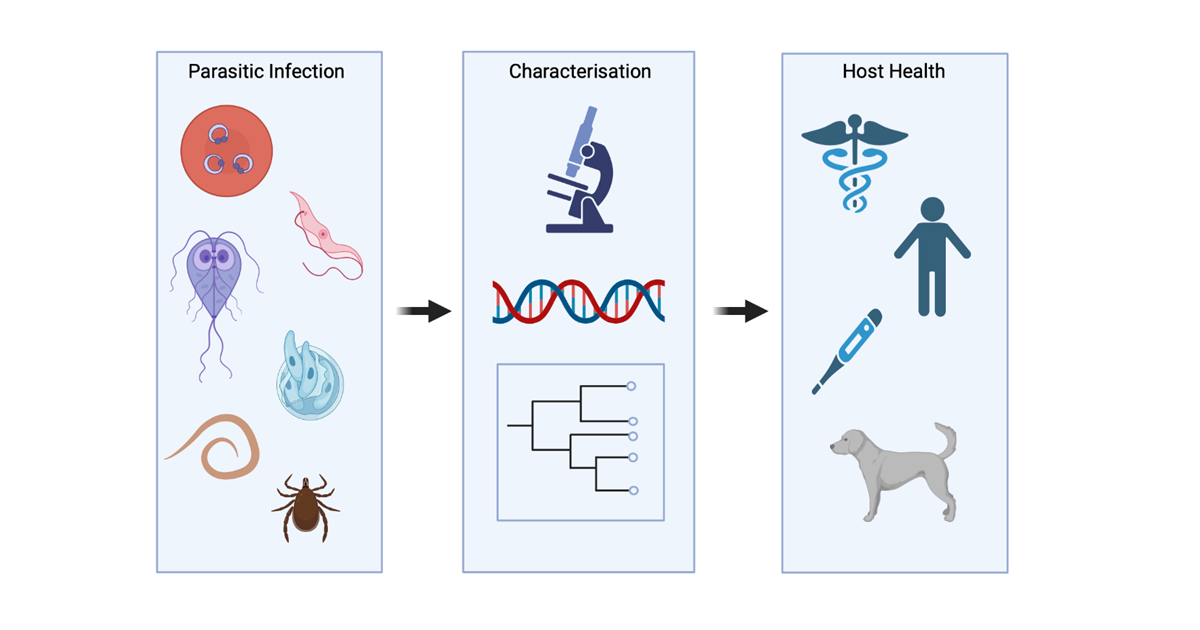Parasites Series: Parasitic Infection, Characterisation and Host Health, Parasitic Diversity and Host Range
A special issue of Pathogens (ISSN 2076-0817). This special issue belongs to the section "Parasitic Pathogens".
Deadline for manuscript submissions: closed (31 March 2025) | Viewed by 25649

Special Issue Editors
Interests: haemoparasites; Trypanosoma; haemoproteidae; wildlife; protozoa; nematoda
Interests: molecular epidemiology; public health; protozoa; water and food-borne parasites
Special Issue Information
Dear Colleagues,
Parasitism is classically defined as a relationship between two living organisms in which one benefits at the expense of the other. Helminths, ectoparasites and protozoa are the three main types of organisms that cause such infections, and vary in size, complexity, and medical and/or veterinary concern. Their life cycles can range from intracellular parasitism to exoparasitism, with completion requiring either a single host species or multiple successive hosts. Parasite transmission roots vary highly, ranging from environmental contamination (contaminated food, water, and fomites) to being reliant on vectors for their continued development, reproduction, and host infection. As natural stressors, parasites often have detrimental effects on their hosts, with clinical severity ranging from asymptomatic to symptomatic, with the outcome of such infections often dependent on the immune status of their host. Acute-to-chronic infections can develop with symptoms associated to helminths and gastrointestinal protozoans (e.g., Cryptosporidium spp. and Giardia) generally leading to malabsorption, vomiting, diarrhoea, and weight loss, while infections with bloodborne parasites (e.g., Plasmodium spp. and Trypanosoma spp.) tend to be associated with haemolytic anaemia, fatigue, joint and muscle pain, headache, flu-like symptoms, encephalitis and behavioural changes. However, interchanges of symptoms can occur, adversely affecting the health and productivity of animal and human populations worldwide. The need to characterise and ascertain all aspects of parasitic infections through biological, chemical, molecular, and epidemiological studies is imperative to address knowledge gaps in the field, which will ultimately facilitate management strategies and treatment options to maintain stable and healthy populations on both a domestic and global scale.
Dr. Jill M. Austen
Dr. Alireza Zahedi
Prof. Dr. Nawal S. H. Hijjawi
Guest Editors
Manuscript Submission Information
Manuscripts should be submitted online at www.mdpi.com by registering and logging in to this website. Once you are registered, click here to go to the submission form. Manuscripts can be submitted until the deadline. All submissions that pass pre-check are peer-reviewed. Accepted papers will be published continuously in the journal (as soon as accepted) and will be listed together on the special issue website. Research articles, review articles as well as short communications are invited. For planned papers, a title and short abstract (about 250 words) can be sent to the Editorial Office for assessment.
Submitted manuscripts should not have been published previously, nor be under consideration for publication elsewhere (except conference proceedings papers). All manuscripts are thoroughly refereed through a single-blind peer-review process. A guide for authors and other relevant information for submission of manuscripts is available on the Instructions for Authors page. Pathogens is an international peer-reviewed open access monthly journal published by MDPI.
Please visit the Instructions for Authors page before submitting a manuscript. The Article Processing Charge (APC) for publication in this open access journal is 2200 CHF (Swiss Francs). Submitted papers should be well formatted and use good English. Authors may use MDPI's English editing service prior to publication or during author revisions.
Keywords
- parasites
- host health
- protozoa
- helminths
- ectoparasites
- diagnosis
- health impacts
Benefits of Publishing in a Special Issue
- Ease of navigation: Grouping papers by topic helps scholars navigate broad scope journals more efficiently.
- Greater discoverability: Special Issues support the reach and impact of scientific research. Articles in Special Issues are more discoverable and cited more frequently.
- Expansion of research network: Special Issues facilitate connections among authors, fostering scientific collaborations.
- External promotion: Articles in Special Issues are often promoted through the journal's social media, increasing their visibility.
- Reprint: MDPI Books provides the opportunity to republish successful Special Issues in book format, both online and in print.
Further information on MDPI's Special Issue policies can be found here.








